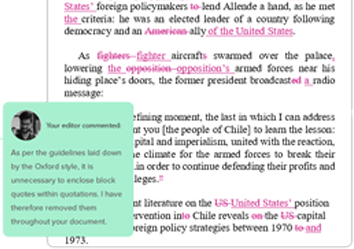Still have questions? Leave a comment

Checklist: Dissertation Proposal
Enter your email id to get the downloadable right in your inbox!
[contact-form-7 id="12425" title="Checklist: Dissertation Proposal"]
Examples: Edited Papers
Enter your email id to get the downloadable right in your inbox!
[contact-form-7 id="12426" title="Examples: Edited Papers"]Need
Editing and
Proofreading Services?

How to Write a Dissertation & Thesis Conclusion (+ Examples)
 Apr 15, 2025
Apr 15, 2025 6
min read
6
min read
- Tags: Academic Writing, Language, Writing Tips
Want to create a strong, impactful conclusion? Explore how to create a dissertation and thesis conclusion in 5 simple steps! To help you understand better, we’ve also included useful dissertation and thesis conclusion examples!
Whether you want to write a conclusion for an empirical or humanities paper, this article will help. So, without delay, let’s understand how to create the best conclusion!
Introduction to writing a conclusion
Writing a conclusion is a crucial part of the research process, as it provides a final opportunity to summarize the main findings, reiterate the thesis statement, and leave a lasting impression on the reader. A strong conclusion should be concise yet comprehensive and provide a broader context for the research. It is essential to avoid simply repeating the introduction or main body of the dissertation and, instead, focus on presenting the key takeaways of the research. In this section, we will explore the importance of writing a great conclusion and provide guidance on how to structure it effectively.
Firstly, let’s know more about the appropriate length of a dissertation and thesis conclusion.
What is the length of a conclusion?
Depending on the complexity of your research and document length, the length will differ. The thesis or dissertation conclusion should be 5-7% of your paper’s overall word count. For example, if your thesis is 30,000 words, the conclusion can be 1,500-2100 words.
The conclusion for empirical or scientific theses or dissertations is often brief. It summarizes the main findings, interprets the research, and discusses the main implications in a few words. In contrast, the thesis or dissertation conclusion for humanities subjects is longer and more reflective.
Understanding the research question
The research question is the foundation of any research project, and it is essential to understand its significance and relevance to the field of study. A well-crafted research question should be specific, measurable, achievable, relevant, and time-bound (SMART), and it should guide the entire research process. In the conclusion chapter, it is essential to revisit the research question and provide a clear answer to it based on the research findings. This will help to demonstrate the contribution of the research to the existing body of knowledge and provide a sense of closure for the reader. Further research can also be suggested to explore the topic in more depth.
Structuring the conclusion chapter
The conclusion chapter should have a typical structure that includes a brief recap of the research problem, a summary of the main findings, and an explanation of the implications of the research. It is essential to use concise language and avoid unnecessary details, as the conclusion should be around 5-10% of the overall word count. The conclusion chapter should also provide a broader perspective on the research and its contribution to the field, and it should be written in a way that is engaging and memorable. The key points to be covered in the conclusion chapter include the research findings, the implications of the research, and the suggestions for future research.
Now, let’s see how to write a conclusion for a thesis/ dissertation in 5 steps!
How to write a dissertation and thesis conclusion
1. Remind readers of the research purpose
For an empirical paper, start your conclusion by revisiting your research question or hypotheses stated earlier in your research. This reminds readers of your study’s main focus and sets the stage for findings. The following is an example:
“This study aimed to investigate the relationship between employee job satisfaction and organizational commitment in the healthcare industry.”
In comparison, while writing the conclusion for a humanities paper, reflect on the research journey. You can also consider the key themes, ideas, arguments, and questions that have guided your research. Here is an example:
“Throughout this thesis, the concept of identity formation in postcolonial literature has been explored, focusing on the works of Chinua Achebe and Chimamanda Ngozi Adichie. The central argument claimed that these authors utilize their narratives to challenge Western hegemonic discourses and assert the agency of African identities.”
2. Summarize main insights
For an empirical paper, summarize your main results and findings concisely. This section should highlight the most significant research outcomes and how they relate to your research questions, hypotheses or research methodology. Here is an example:
“The results of this study demonstrated a significant positive correlation between employee job satisfaction and organizational commitment (r = 0.78, p < 0.001). Multiple regression analysis revealed that job satisfaction, along with factors such as work-life balance and leadership support, accounted for 65% of the variance in organizational commitment scores.”
On the other hand, if it’s a humanities paper, you can summarize any evidence or examples that support your claims about the research in your conclusion. Here is an example:
“The analysis of Achebe’s ‘Things Fall Apart’ and Adichie’s ‘Purple Hibiscus’ reveals a common thread of resistance against colonial oppression and the assertion of African identity. Both authors employ narrative techniques that subvert Western stereotypes and provide a nuanced portrayal of African experiences. Through their characters’ journeys, Achebe and Adichie challenge the notion of a singular African identity and highlight the complexities of postcolonial life.”
3. Suggest practical applications, future recommendations, and limitations
Mention how your research can be practically applied (if relevant) and make suggestions for future research. Explain the broader significance of your findings while writing a dissertation conclusion/thesis conclusion. If there are any limitations, you can add them to this part. Here is an example:
“The findings have implications for healthcare organizations aiming to improve employee retention and well-being, with potential benefits for patient care and organizational performance. However, the study’s limitations, such as its specific sample size and setting make it difficult to generalize these findings. Further research is needed to explore the effectiveness of interventions targeting these factors across diverse healthcare contexts and to investigate additional variables that may impact organizational commitment.”
In contrast, here is another conclusion example for an empirical paper:
“The comparative analysis of Achebe and Adichie’s works has significant implications for the study of postcolonial literature. By highlighting the diversity of African experiences and the importance of cultural identity, these authors challenge the notion of a monolithic African narrative. This research also raises important questions about the role of literature in shaping cultural perceptions and the impact of colonialism on contemporary African societies.”
Browse through the next step of how to write a conclusion for a dissertation/thesis! This step demonstrates your research’s importance in a broader context.
4. Highlight your research’s significance
In this part, write about how your research has contributed new knowledge to your field. You can briefly explain how the research conducted has filled a gap in your field of study. By using relevant academic research resources like Google Scholar, you can understand the research already conducted and use relevant references in your conclusion.
If your research proves or disproves a certain theory or assumption, you can mention that. Also, if you’ve mentioned the gap in the literature review, you can remind readers about this.
Here is an example of how to highlight your research’s significance for an empirical paper:
“This study contributes to the growing body of research on the impact of social media on adolescent mental health. By utilizing a longitudinal design and a large, diverse sample, this study provides robust evidence for the relationship between social media usage and negative mental health outcomes. The findings also highlight the importance of considering the role of specific social media platforms and usage patterns in shaping mental health, which has been overlooked in previous research.”
In contrast, in a humanities paper, you should focus on how your insights contribute to the broader discourse in your field and any new perspectives or interpretations.
The following is an example:
“This comparative analysis of Achebe and Adichie’s works contributes to the growing body of postcolonial literary criticism by highlighting the importance of considering the diversity of African experiences and the ongoing impact of colonialism on contemporary African societies. By focusing on the theme of cultural identity and the use of narrative techniques that subvert Western stereotypes, this research offers a new lens through which to interpret these authors’ works and their significance within the canon of African literature.”
Now, let’s understand the last step of how to write a dissertation conclusion/thesis conclusion!
5. Strongly conclude your thesis or dissertation
End with an impactful statement that summarizes a key takeaway or highlights your work’s broader significance.
Here is an example of an empirical paper conclusion:
“By investing in evidence-based strategies to promote mental health in the workplace, we can foster a more resilient and productive workforce for the future.”
In contrast, the following is an example of the final statement for a humanities paper:
“In the final analysis, the enduring legacy of these writers lies in their ability to touch the depths of the human soul, awakening us to the transformative power of language, story, and imagination.”
After concluding your thesis, to enhance your thesis further, you can take the help of online thesis editing and proofreading services.
Literature Review Reflection
The literature review is an essential part of any research project as it provides a comprehensive overview of the existing body of knowledge on the topic. In the conclusion chapter, it is essential to reflect on the literature review and provide an analysis of the key findings and implications. This will help to demonstrate the significance of the research and its contribution to the existing body of knowledge. The literature review reflection should also provide a critical evaluation of the existing theory and its limitations, and it should suggest areas for further exploration. The conclusion chapter should also provide a sense of closure and finality, and it should leave the reader with a lasting impression of the research.
Emphasizing Contributions to the Field
The conclusion chapter should emphasize the contributions of the research to the field of study, and it should provide a clear explanation of the implications of the research. The contributions can be theoretical, practical, or empirical, and they should be based on the research findings. The conclusion chapter should also provide suggestions for future research and recommendations for practitioners or policymakers. The key arguments and findings of the research should be summarized, and the conclusion chapter should provide a final opportunity to present the key takeaways and implications of the research. The conclusion chapter should be written in a way that is engaging and memorable, and it should leave the reader with a lasting impression of the research and its contribution to the field.
Now, let us see the dos and don’ts to follow while writing a thesis conclusion!
Dos and don’ts while writing a conclusion
Suggested sentence structures for framing the conclusion
Depending on whether you’re writing an empirical or humanities paper, you can use and customize these sentence structures for your thesis or dissertation conclusion.
- This study aimed to investigate the…
- The results of this study demonstrate that…
- The analysis of the data revealed that…
- The findings of this study have significant implications for…
- The insights gained from this research have important implications for…
- The key findings of this research indicate…
- Further research is needed to explore….
- By investigating [write the research purpose], this study found out [write the main findings].
- This study makes a notable contribution to the field of…[field name] by [write the contribution]
- While this study demonstrates the potential for [practical application], further research is required to explore…
- To conclude, the insights gained from this research…
- This dissertation fills a crucial gap in the literature by…
- This study offers valuable insights that can…
- In summary, this study…
- In closing, this dissertation…
This concludes our guide about how to write a thesis conclusion and dissertation conclusion. You can bookmark this article to revisit any thesis and dissertation conclusion examples. Once you write the conclusion and complete your paper, you’ll need to edit and proofread your thesis or dissertation. As experts in editing and proofreading services, we’d love to help you perfect your paper!
Here are some other articles you might find interesting:

Rishi

Rishi was a zealous student at IIT Bombay when he realized, firsthand, the power of good language in effective communication. As part of this belief, after a brief stint in a hedge fund, he co-founded PaperTrue in 2014.
4 comments on “How to Write a Dissertation & Thesis Conclusion (+ Examples)”
Comments are closed.






Your blog on dissertation and thesis conclusions is exceptionally insightful! It offers clear, practical guidance, and the tips are incredibly valuable for both beginners and experienced researchers. Great job!
This blog post offers valuable insights into crafting a strong conclusion for dissertations and theses. The emphasis on summarizing key findings while providing a forward-looking perspective is especially helpful. It’s a great resource for anyone aiming to enhance their academic writing skills.
This blog on writing a strong dissertation conclusion is incredibly helpful! The clear breakdown of steps and focus on key elements like summarizing research contributions make the process feel much more approachable. A must-read for anyone working on their thesis or dissertation.
This blog provides clear and practical insights on writing an impactful dissertation and thesis conclusion. The step-by-step approach to summarizing key findings and reinforcing arguments is truly helpful for students. A must-read for anyone looking to craft a strong and compelling conclusion.